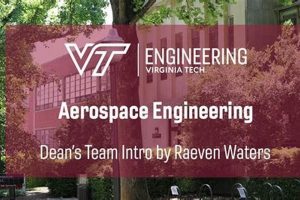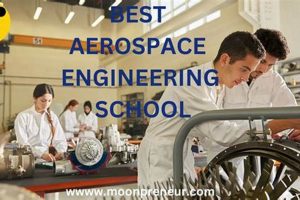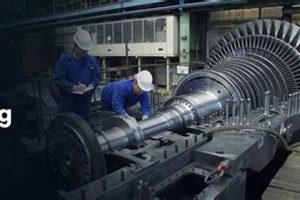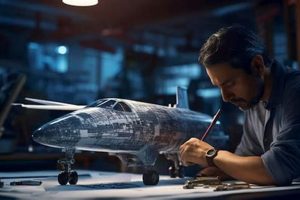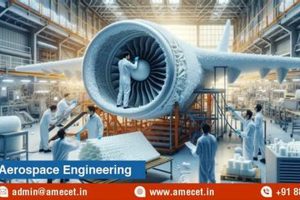The curriculum for aspiring aerospace professionals encompasses a broad range of scientific and engineering disciplines necessary for the design, development, and testing of aircraft and spacecraft. This includes advanced mathematics, physics, aerodynamics, propulsion systems, structural mechanics, control systems, and materials science. For example, a student might analyze the airflow over a wing using computational fluid dynamics or design a satellite’s attitude control system.
A thorough understanding of these subjects is crucial for creating safe, efficient, and innovative aerospace vehicles. This field directly contributes to advancements in air travel, space exploration, national defense, and scientific research. Historically, the pursuit of flight has driven technological progress, and today, the challenges of space travel and the development of sustainable aviation fuels continue to spur innovation. The benefits extend to broader economic growth through job creation and technological spin-offs.
This interdisciplinary education subsequently equips graduates to tackle complex challenges in areas such as aircraft design, spacecraft engineering, propulsion system development, and the creation of advanced materials for extreme environments. The following sections will detail specific areas of focus within this broad curriculum, illuminating the depth and breadth of knowledge required to succeed in this field.
Guidance for Prospective Aerospace Engineers
Aspirants seeking a career in aerospace engineering should prioritize a rigorous academic foundation and practical experience to maximize their potential.
Tip 1: Emphasize a strong mathematics background. Proficiency in calculus, differential equations, and linear algebra is essential for understanding the fundamental principles governing aerospace systems.
Tip 2: Gain practical experience through internships or research opportunities. Hands-on involvement in projects related to aircraft design, spacecraft engineering, or propulsion systems provides invaluable insights and strengthens theoretical knowledge.
Tip 3: Develop proficiency in computer-aided design (CAD) and simulation software. Mastery of industry-standard tools such as CATIA, ANSYS, or MATLAB is crucial for designing, analyzing, and optimizing aerospace components and systems.
Tip 4: Cultivate strong problem-solving skills. Aerospace engineering involves addressing complex challenges with innovative solutions. Practice critical thinking and develop analytical abilities to effectively troubleshoot and resolve engineering problems.
Tip 5: Focus on understanding aerodynamics and fluid dynamics. A deep understanding of airflow principles is fundamental for designing efficient and stable aircraft and spacecraft.
Tip 6: Explore materials science and engineering. Aerospace vehicles require materials that can withstand extreme temperatures, pressures, and stresses. Knowledge of material properties and selection is critical for ensuring structural integrity and performance.
Tip 7: Engage in continuous learning and professional development. The aerospace field is constantly evolving. Stay abreast of the latest advancements in technology and engineering practices through conferences, publications, and continuing education courses.
Following these guidelines will equip aspiring aerospace engineers with the skills and knowledge necessary to excel in this demanding and rewarding field, enabling them to contribute to the advancement of air and space travel.
The subsequent conclusion will further elaborate on the significance of aerospace engineering and its future impact.
1. Aerodynamics
Aerodynamics, the study of air in motion and its interaction with solid objects, constitutes a cornerstone of aerospace engineering education. The performance, stability, and control of aircraft and spacecraft are directly governed by aerodynamic principles. A thorough comprehension of aerodynamics allows engineers to predict and manipulate airflow to optimize lift, minimize drag, and enhance overall vehicle efficiency. For instance, the design of an aircraft wing relies heavily on aerodynamic analysis to ensure adequate lift generation at various speeds and altitudes. Similarly, the streamlining of a rocket’s nose cone is critical for reducing aerodynamic drag during atmospheric ascent. Without a firm grasp of these principles, the design and operation of safe and effective aerospace vehicles would be impossible.
Aerodynamic studies within aerospace engineering curricula typically involve both theoretical and experimental approaches. Students learn to apply fundamental equations of fluid dynamics, such as the Navier-Stokes equations, to model airflow around complex geometries. Computational Fluid Dynamics (CFD) software is also employed to simulate and analyze aerodynamic phenomena, providing valuable insights into flow behavior that are difficult to obtain through analytical methods alone. Wind tunnel testing remains an essential tool for validating theoretical models and CFD simulations, as well as for evaluating the aerodynamic performance of prototype designs. The combination of these methods provides a comprehensive understanding of aerodynamic principles and their practical application.
In summary, the study of aerodynamics is inextricably linked to the broader field of aerospace engineering. Its significance lies in its direct impact on the performance, efficiency, and safety of aircraft and spacecraft. A comprehensive understanding of aerodynamic principles, coupled with practical experience in CFD simulations and wind tunnel testing, equips aerospace engineers with the necessary tools to design and develop innovative aerospace vehicles capable of meeting the challenges of air and space travel.
2. Propulsion Systems
The study of propulsion systems forms a critical component of aerospace engineering curricula, directly influencing the performance capabilities of both aircraft and spacecraft. Propulsion systems provide the necessary thrust to overcome drag and gravitational forces, enabling sustained flight and space travel. A deep understanding of various propulsion technologies, including jet engines, rocket engines, and electric propulsion systems, is therefore essential for aerospace engineers. The type of propulsion system selected dictates the achievable speed, altitude, range, and payload capacity of an aerospace vehicle. For example, a commercial airliner relies on high-bypass turbofan engines for efficient long-distance travel, while a space launch vehicle necessitates powerful rocket engines to escape Earth’s gravity. The specific study of propulsion systems is not merely theoretical; it’s inherently connected to the operational parameters and overall success of aerospace missions.
The practical application of propulsion system knowledge extends to diverse areas such as engine design, performance analysis, and system integration. Aerospace engineers analyze thermodynamic cycles, combustion processes, and fluid dynamics to optimize engine efficiency and minimize emissions. They also evaluate the structural integrity and thermal management of propulsion systems to ensure reliable operation under extreme conditions. Furthermore, the integration of propulsion systems with airframes or spacecraft requires careful consideration of factors such as weight distribution, aerodynamic drag, and control system interactions. The development of advanced propulsion technologies, such as scramjets for hypersonic flight and ion thrusters for deep-space missions, presents ongoing engineering challenges that require innovative solutions and a comprehensive understanding of fundamental principles.
In summary, the study of propulsion systems is indispensable for aerospace engineers, directly influencing the design, performance, and operational capabilities of aircraft and spacecraft. This field demands a thorough understanding of thermodynamics, fluid mechanics, combustion, and materials science, coupled with practical skills in engine design, performance analysis, and system integration. Continued advancements in propulsion technology will drive future progress in air and space travel, enabling faster, more efficient, and more sustainable transportation systems.
3. Structural Mechanics
Structural mechanics, a critical domain within aerospace engineering curricula, focuses on analyzing the behavior of solid materials and structures under various loads and environmental conditions. This field is paramount in ensuring the integrity, safety, and performance of aircraft and spacecraft. The principles of structural mechanics are applied throughout the design and development process, from initial concept to final certification, to guarantee that aerospace vehicles can withstand the forces encountered during flight and operation.
- Stress Analysis
Stress analysis involves determining the internal stresses and strains within a structural component subjected to external loads. Aerospace engineers utilize analytical techniques, such as finite element analysis (FEA), to predict stress distributions and identify critical areas prone to failure. For example, the wing of an aircraft experiences significant bending and torsional stresses during flight. Accurate stress analysis ensures that the wing structure can withstand these loads without exceeding its material strength, thus preventing catastrophic failure. This is a fundamental skill for ensuring structural reliability.
- Material Properties
A thorough understanding of material properties is essential in structural mechanics. Aerospace materials, such as aluminum alloys, titanium alloys, and composites, exhibit unique mechanical behaviors. Engineers must consider factors like tensile strength, yield strength, fatigue resistance, and creep resistance when selecting materials for specific applications. For instance, the selection of a high-strength, lightweight composite material for an aircraft fuselage can significantly improve fuel efficiency and overall performance. Therefore, careful consideration of material properties is crucial in optimizing structural designs.
- Buckling Analysis
Buckling analysis examines the stability of slender structural elements under compressive loads. Buckling can lead to catastrophic failure, even if the applied stresses are below the material’s yield strength. Aerospace structures, such as fuselage panels and wing spars, are often susceptible to buckling. Engineers employ analytical and numerical methods to predict buckling loads and design structures that can resist buckling under operational conditions. The design of a spacecraft’s launch adapter, which must withstand significant compressive loads during launch, relies heavily on buckling analysis to ensure structural integrity.
- Vibration Analysis
Vibration analysis assesses the dynamic response of structures to oscillatory loads. Excessive vibration can lead to fatigue failure and reduced performance. Aerospace engineers perform modal analysis to identify natural frequencies and mode shapes, which are then used to design structures that minimize resonant vibrations. For instance, the engine nacelle of an aircraft must be designed to withstand vibrations induced by the engine, preventing fatigue damage and ensuring structural integrity. Careful vibration analysis is critical for minimizing noise and ensuring passenger comfort.
These facets of structural mechanics collectively contribute to the overall safety and efficiency of aerospace vehicles. Proficiency in these areas is an indispensable part of what aerospace engineers study, equipping them with the ability to design robust, reliable, and high-performance structures that meet the stringent demands of air and space travel. The continuous development of advanced materials and analytical techniques further underscores the importance of structural mechanics in the future of aerospace engineering.
4. Control Systems
Control systems represent a crucial area of study for aerospace engineers, dictating the stability, maneuverability, and overall performance of aircraft and spacecraft. Understanding control systems is integral to designing vehicles that can effectively navigate atmospheric and extraterrestrial environments. The study encompasses principles of feedback control, system modeling, and controller design, enabling engineers to develop automated systems that maintain desired flight paths, attitudes, and engine parameters. Failure within a control system can have catastrophic consequences; therefore, rigorous analysis and robust design are paramount. Examples of control systems in aerospace include autopilot systems in commercial aircraft, attitude control systems in satellites, and guidance systems in missiles. These systems rely on sophisticated algorithms and sensors to continuously monitor and adjust vehicle behavior based on real-time conditions. The effectiveness of these systems directly impacts mission success and safety.
The practical application of control systems knowledge involves various aspects of aerospace vehicle design. Engineers must consider factors such as aerodynamic characteristics, engine performance, and sensor accuracy when developing control algorithms. Simulation software plays a significant role in testing and validating control system designs before implementation in actual hardware. Furthermore, the integration of control systems with other vehicle subsystems, such as navigation and communication systems, requires careful consideration of interoperability and data flow. Advanced control techniques, such as adaptive control and model predictive control, are increasingly employed to address the challenges of complex aerospace systems, particularly those operating in uncertain or dynamic environments. These techniques allow control systems to adjust their behavior based on changing conditions, ensuring stable and reliable performance.
In conclusion, control systems form an indispensable element of what aerospace engineers study, providing the foundation for developing safe, efficient, and reliable aircraft and spacecraft. The challenges associated with designing and implementing robust control systems require a deep understanding of theoretical principles and practical considerations. Continued advancements in control system technology will drive future progress in air and space travel, enabling more autonomous and capable aerospace vehicles. The significance of this study is underscored by the inherent risks associated with aerospace operations, where system failures can have severe repercussions, thus emphasizing the importance of robust and reliable control system design.
5. Materials Science
Materials science holds a pivotal position within the aerospace engineering discipline. The selection, characterization, and application of materials directly influence the performance, safety, and longevity of aircraft and spacecraft. A thorough understanding of material properties and behavior under extreme conditions is therefore essential for aerospace engineers.
- High-Strength, Lightweight Alloys
Aerospace applications demand materials with exceptional strength-to-weight ratios. Aluminum alloys, titanium alloys, and nickel-based superalloys are commonly employed due to their ability to withstand high stresses at elevated temperatures while minimizing overall vehicle weight. For example, aluminum alloys are extensively used in aircraft fuselages and wings, while titanium alloys find application in engine components exposed to extreme heat. The development of new alloys with improved strength and reduced density remains a crucial area of research within materials science, directly impacting the fuel efficiency and payload capacity of aerospace vehicles.
- Composite Materials
Composite materials, such as carbon fiber reinforced polymers (CFRPs) and glass fiber reinforced polymers (GFRPs), offer significant weight savings compared to traditional metallic alloys. These materials exhibit high strength and stiffness, while also being resistant to corrosion and fatigue. CFRPs are increasingly used in aircraft wings, tail sections, and fuselage structures, as well as in spacecraft components. The study of composite materials involves understanding their anisotropic properties, manufacturing processes, and long-term durability in harsh environments. Optimization of composite layups and resin systems is a key area of focus for aerospace engineers seeking to maximize structural performance and minimize weight.
- Thermal Protection Systems
Spacecraft re-entering Earth’s atmosphere experience extreme heating due to atmospheric friction. Thermal protection systems (TPS) are essential for safeguarding the spacecraft structure and its occupants. Materials used in TPS must possess exceptional heat resistance, low thermal conductivity, and ablative properties. Examples of TPS materials include ceramic tiles, carbon-carbon composites, and heat-resistant polymers. The design and analysis of TPS require a deep understanding of heat transfer mechanisms, material ablation rates, and structural integrity at high temperatures. Precise thermal modeling and experimental testing are crucial for ensuring the effectiveness of TPS in protecting spacecraft during re-entry.
- Advanced Manufacturing Techniques
The fabrication of aerospace components often requires advanced manufacturing techniques, such as additive manufacturing (3D printing) and advanced joining methods. Additive manufacturing allows for the creation of complex geometries and customized designs, enabling the production of lightweight and highly optimized structural components. Advanced joining methods, such as friction stir welding and laser welding, provide strong and reliable joints in aerospace structures. The study of these manufacturing techniques involves understanding their limitations, process parameters, and the resulting material properties. Aerospace engineers must be proficient in selecting and implementing appropriate manufacturing processes to ensure the quality and performance of aerospace components.
The exploration of materials science is therefore inextricably linked to the core competencies of aerospace engineers. From the selection of appropriate alloys to the design of advanced thermal protection systems and the implementation of novel manufacturing techniques, a thorough understanding of materials science is essential for creating safe, efficient, and high-performing aerospace vehicles. Continuous advancements in materials technology will continue to drive innovation in the aerospace industry, enabling the development of more capable and sustainable air and space transportation systems.
6. Orbital Mechanics
Orbital mechanics forms a fundamental component of aerospace engineering education, providing the theoretical framework for understanding and predicting the motion of spacecraft and other celestial bodies. The principles of orbital mechanics are essential for designing space missions, launching satellites, and navigating interplanetary trajectories.
- Keplerian Elements
Keplerian elements, a set of six parameters, define the shape and orientation of an orbit in space. These elements include semi-major axis, eccentricity, inclination, longitude of ascending node, argument of periapsis, and true anomaly. Understanding Keplerian elements is crucial for determining a spacecraft’s position and velocity at any given time. For example, mission planners utilize Keplerian elements to predict the trajectory of a satellite and schedule maneuvers to maintain its desired orbit. The precise manipulation of these elements is fundamental to orbital adjustments and rendezvous operations.
- Orbital Maneuvers
Orbital maneuvers involve changing a spacecraft’s orbit by applying thrust. These maneuvers can include Hohmann transfers for changing altitude, inclination changes for aligning orbits, and phasing maneuvers for adjusting the spacecraft’s position along its orbit. Aerospace engineers must calculate the required thrust and burn duration for each maneuver, taking into account the spacecraft’s mass, engine performance, and orbital parameters. For instance, a Hohmann transfer is commonly used to move a satellite from a low Earth orbit to a geostationary orbit. The efficiency and accuracy of orbital maneuvers are critical for mission success and fuel conservation.
- Perturbations
Perturbations are deviations from ideal Keplerian motion caused by various factors, such as the gravitational influence of other celestial bodies, atmospheric drag, and solar radiation pressure. These perturbations can significantly alter a spacecraft’s orbit over time. Aerospace engineers must model and account for these perturbations when designing long-duration missions. For example, the gravitational influence of the Moon and Sun can cause significant perturbations in the orbit of a satellite in geostationary orbit. Accurate modeling of perturbations is essential for maintaining the satellite’s position and ensuring its operational lifespan.
- Interplanetary Trajectories
Interplanetary trajectories involve navigating spacecraft between planets in the solar system. These trajectories often utilize gravity assists, where the spacecraft’s trajectory is altered by the gravitational field of a planet, allowing it to gain speed and change direction without expending propellant. Aerospace engineers must carefully plan interplanetary trajectories to minimize travel time and fuel consumption. For example, the Voyager missions utilized gravity assists from multiple planets to explore the outer solar system. The design of interplanetary trajectories requires a deep understanding of celestial mechanics and the gravitational interactions between spacecraft and planets.
These core areas within orbital mechanics underscore its integral role in what aerospace engineers study, equipping them with the necessary knowledge to design and execute successful space missions. The ability to accurately predict and control the motion of spacecraft is crucial for a wide range of applications, including satellite communications, Earth observation, space exploration, and national defense. Continued advancements in orbital mechanics and spacecraft propulsion will drive future progress in space travel and exploration.
7. Flight Dynamics
Flight dynamics, a core discipline within aerospace engineering, concerns itself with the study of an aircraft’s motion through the air and its response to control inputs and external disturbances. Its importance stems from the need to ensure stability, controllability, and satisfactory handling qualities of aircraft across a range of flight conditions. The connection to what aerospace engineers study is direct: a deep understanding of flight dynamics is necessary for designing aircraft that are safe, efficient, and capable of performing their intended mission. For example, the design of an aircraft’s control surfaces (ailerons, elevators, rudder) relies heavily on flight dynamics principles to achieve desired maneuverability and stability characteristics. Insufficient consideration of flight dynamics can result in aircraft that are difficult to control or prone to dangerous instabilities.
The study of flight dynamics encompasses several key areas, including static stability, dynamic stability, and control system design. Static stability refers to an aircraft’s tendency to return to its equilibrium state after a disturbance, while dynamic stability describes how the aircraft oscillates over time as it returns to equilibrium. Aerospace engineers analyze these characteristics to ensure that the aircraft is naturally stable and possesses acceptable damping properties. Control system design involves developing systems that allow the pilot to effectively control the aircraft’s motion. This includes designing control laws that provide desired responsiveness and stability augmentation systems that enhance handling qualities. A practical example is the fly-by-wire system used in modern commercial aircraft, which relies on complex flight dynamics models and control algorithms to provide precise and safe control.
In summary, flight dynamics is an essential element of the knowledge base acquired by aerospace engineers. Its principles underpin the design of safe, stable, and controllable aircraft. The understanding of static and dynamic stability, coupled with the ability to design effective control systems, is critical for ensuring the success of any aircraft design project. Challenges in flight dynamics often arise from the complex interplay of aerodynamic forces, structural dynamics, and control system behavior, requiring engineers to employ advanced modeling techniques and simulation tools. The study of flight dynamics is inseparable from the broader field of aerospace engineering, contributing directly to the advancement of aviation technology.
Frequently Asked Questions
The following addresses common inquiries concerning the academic disciplines encompassed by aerospace engineering programs, providing clarity on the scope and depth of knowledge required for successful careers in this field.
Question 1: What is the primary focus of study in aerospace engineering programs?
Aerospace engineering curricula primarily focus on the design, development, testing, and production of aircraft and spacecraft. This involves a multidisciplinary approach integrating principles from physics, mathematics, and engineering disciplines.
Question 2: Does aerospace engineering encompass both aeronautical and astronautical engineering?
Yes, aerospace engineering is a broad field encompassing both aeronautical engineering, which deals with aircraft operating within Earth’s atmosphere, and astronautical engineering, which focuses on spacecraft and space travel beyond Earth’s atmosphere.
Question 3: What role does mathematics play in aerospace engineering studies?
Mathematics is fundamental to aerospace engineering. Students must develop a strong foundation in calculus, differential equations, linear algebra, and numerical methods to analyze complex systems and solve engineering problems.
Question 4: Is computer programming a significant component of aerospace engineering studies?
Yes, computer programming is essential. Aerospace engineers utilize programming languages such as Python, MATLAB, and C++ for simulations, data analysis, and control system design.
Question 5: How does practical experience supplement academic learning in aerospace engineering?
Practical experience, gained through internships, research projects, and laboratory work, is crucial for applying theoretical knowledge to real-world problems and developing essential engineering skills.
Question 6: What career paths are available to graduates with aerospace engineering degrees?
Aerospace engineering graduates find employment in diverse roles, including aircraft design, spacecraft engineering, propulsion system development, research and development, and government agencies such as NASA and the Department of Defense.
In summary, aerospace engineering demands a broad and deep understanding of numerous scientific and engineering principles. The curriculum prepares individuals to address complex challenges in the design, development, and operation of air and space vehicles.
The subsequent section will synthesize the key aspects of aerospace engineering studies, underscoring its importance in driving technological advancement and societal progress.
Conclusion
This exploration of what aerospace engineers study reveals a comprehensive, interdisciplinary curriculum essential for advancing air and space travel. The mastery of aerodynamics, propulsion systems, structural mechanics, control systems, materials science, orbital mechanics, and flight dynamics forms the bedrock of this profession. It demands a rigorous understanding of theoretical principles combined with practical application, equipping engineers to design, develop, and maintain safe, efficient, and innovative aerospace vehicles.
The pursuit of knowledge in these specialized areas directly contributes to technological progress and societal benefit, ranging from improved air transportation to expanded space exploration capabilities. Continued dedication to these fundamental areas of study will be critical in addressing future challenges and realizing the full potential of aerospace engineering to shape the future of flight and spacefaring endeavors. Society must recognize and support the continued education and development of these vital engineers.


